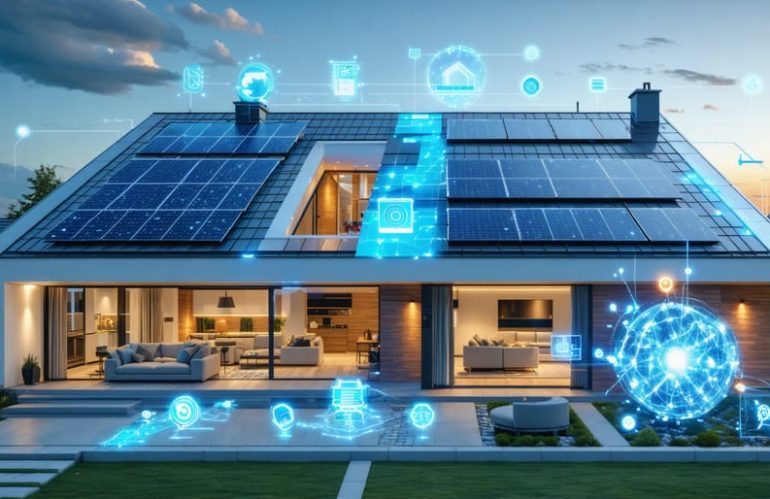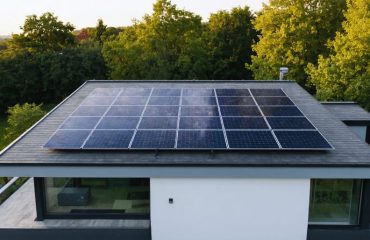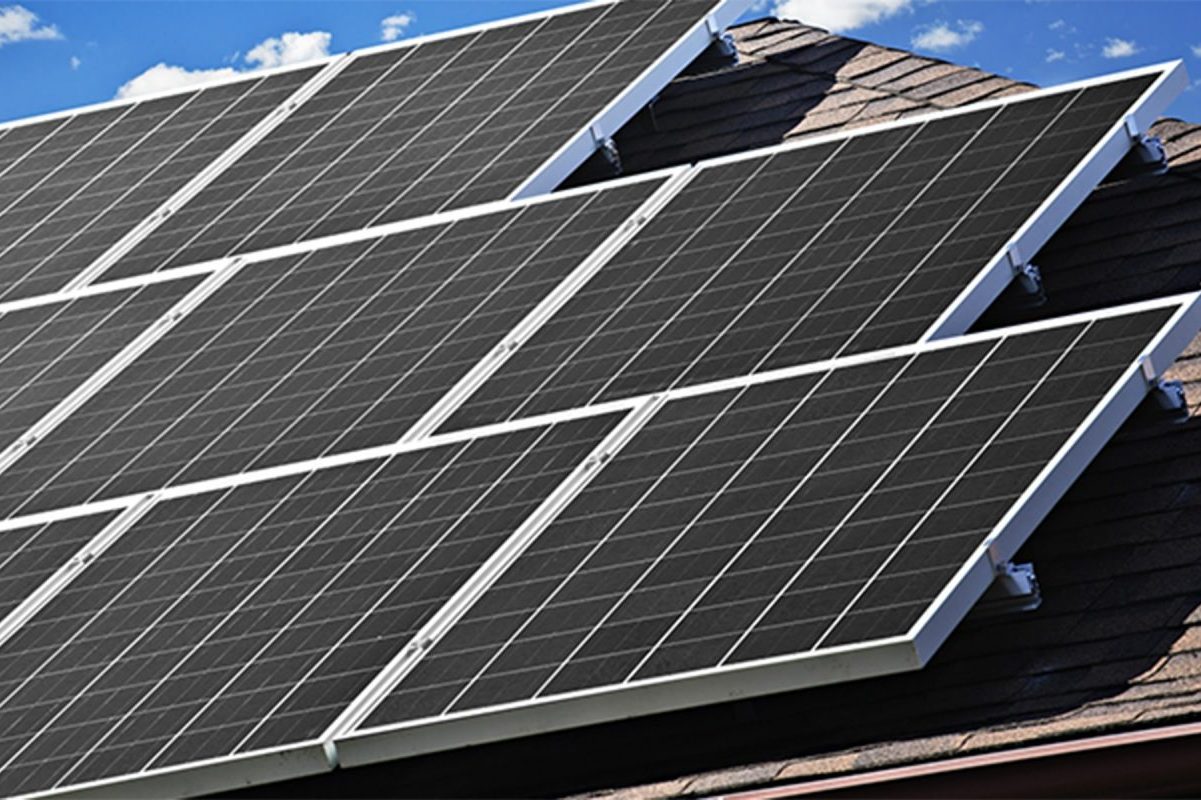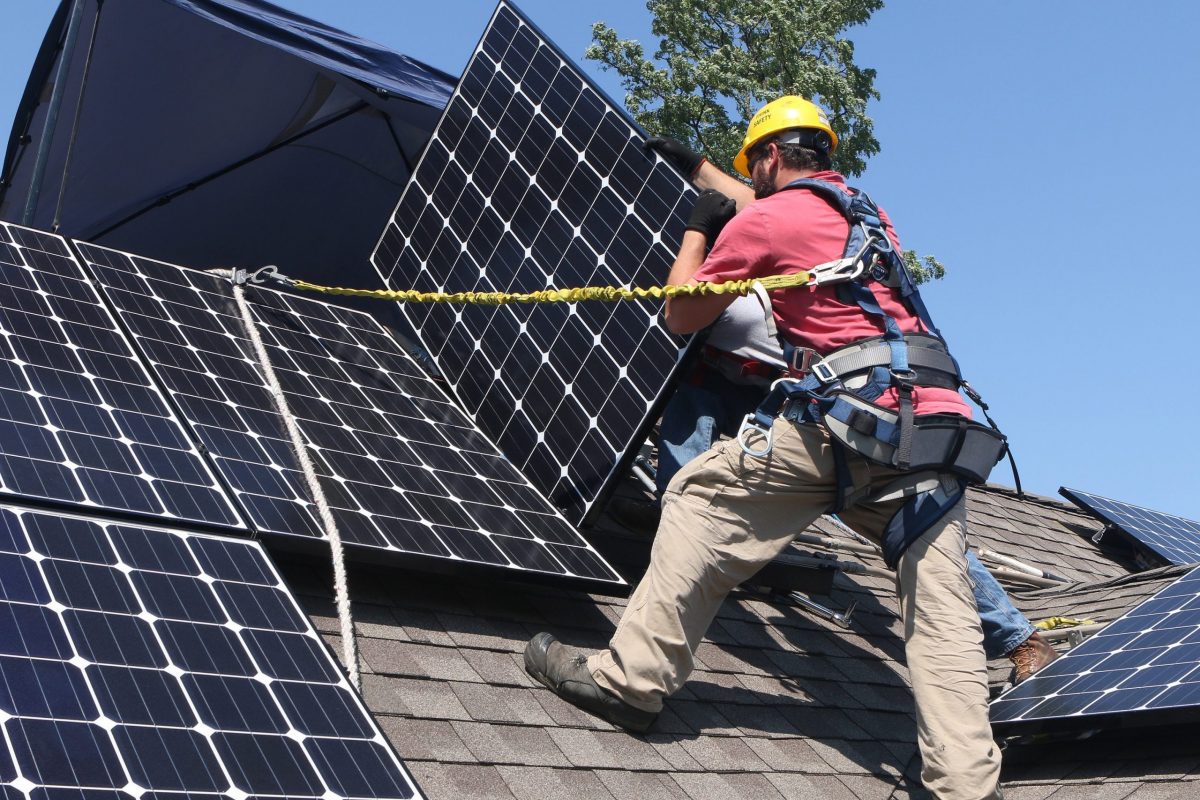Solar energy innovation stands at the forefront of today’s clean energy transition, revolutionizing how homeowners power their lives. Recent breakthroughs in solar technology have made residential solar systems more efficient, affordable, and accessible than ever before. From ultra-thin perovskite cells that capture more sunlight to smart inverters that optimize energy production throughout the day, these innovations are transforming ordinary rooftops into powerful energy generators.
The impact extends beyond just technical improvements. New financing options, simplified installation processes, and enhanced battery storage solutions are making solar adoption practical for more homeowners. Advanced monitoring systems now allow residents to track their energy production in real-time through smartphone apps, while integrated home energy management systems automatically adjust usage patterns to maximize solar efficiency.
As we witness this solar revolution, the benefits become increasingly clear: lower electricity bills, increased home values, and reduced carbon footprints. These innovations aren’t just reshaping our energy landscape – they’re empowering homeowners to take control of their energy future while contributing to a more sustainable world.
Next-Generation Solar Panel Technology
Perovskite Solar Cells
One of the most exciting breakthroughs in solar technology is the development of perovskite solar cells, which promise to revolutionize how we harness solar energy. These innovative cells use a special crystal structure that can be manufactured at much lower temperatures than traditional silicon cells, making them significantly cheaper to produce.
What makes perovskite cells particularly impressive is their rapid improvement in efficiency. In just a decade, researchers have pushed their efficiency from about 3% to over 25%, rivaling the performance of conventional silicon panels. Even more promising is their potential to be combined with existing silicon technology, creating “tandem cells” that could exceed 30% efficiency – a marked improvement over current residential solar panels.
For homeowners, this technology could mean more affordable solar installations in the coming years. Perovskite cells can be produced as thin, lightweight, and even semi-transparent materials, opening up new possibilities for installation on windows, curved surfaces, and areas that couldn’t previously support traditional panels. Their flexibility in application could make solar power more accessible for homes with challenging roof configurations or limited space.
While perovskite technology is still being perfected for long-term durability and weather resistance, researchers are making steady progress. Industry experts predict that these cells could enter the residential market within the next few years, potentially cutting solar installation costs by 40% or more. This advancement could make the switch to solar power more attractive and accessible for average homeowners, accelerating the transition to clean energy.
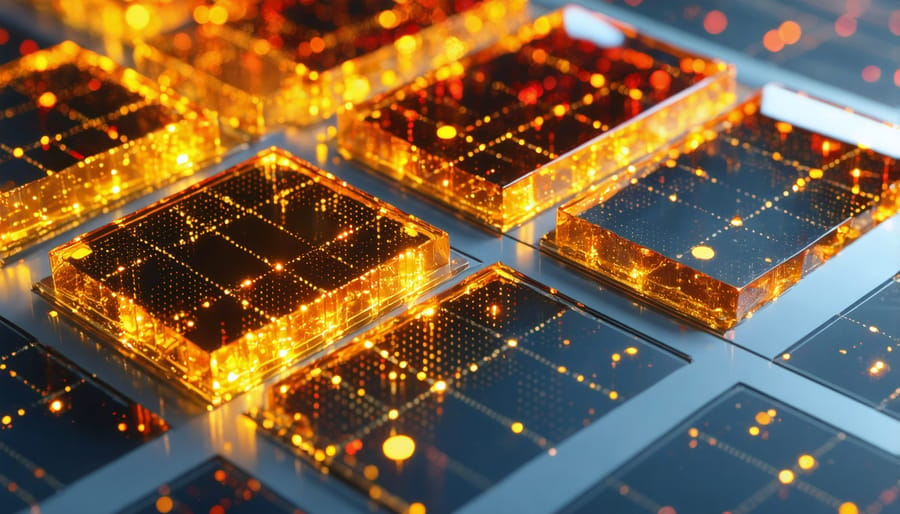
Bifacial Solar Panels
Imagine capturing sunlight from both sides of your solar panels – that’s exactly what bifacial solar panels do. These innovative panels generate power from both their front and back surfaces, allowing them to harness direct sunlight and reflected light simultaneously. This dual-sided design can increase energy production by 5-30% compared to traditional single-sided panels.
Bifacial panels work particularly well in certain environments. Snow-covered ground, light-colored roofs, or even pale concrete can reflect significant amounts of light onto the panels’ rear surface, boosting their overall efficiency. They’re especially effective when mounted on raised racks or used in ground installations where light can easily reach both sides.
For homeowners, this means more power generation in the same amount of space. A typical residential installation using bifacial panels might produce noticeably more energy throughout the year, potentially leading to greater electricity bill savings. While these panels may cost slightly more upfront, the increased energy production often justifies the investment over time.
The technology has advanced significantly in recent years, with manufacturers developing more efficient designs and more durable materials. Modern bifacial panels are built to last, typically coming with warranties similar to traditional panels while offering the advantage of dual-sided power generation.
As an added benefit, bifacial panels can perform better in cloudy conditions, as they can capture diffused light from both sides. This makes them an excellent choice for regions that don’t experience constant direct sunlight, helping homeowners maintain steady energy production even on overcast days.
Smart Solar Integration
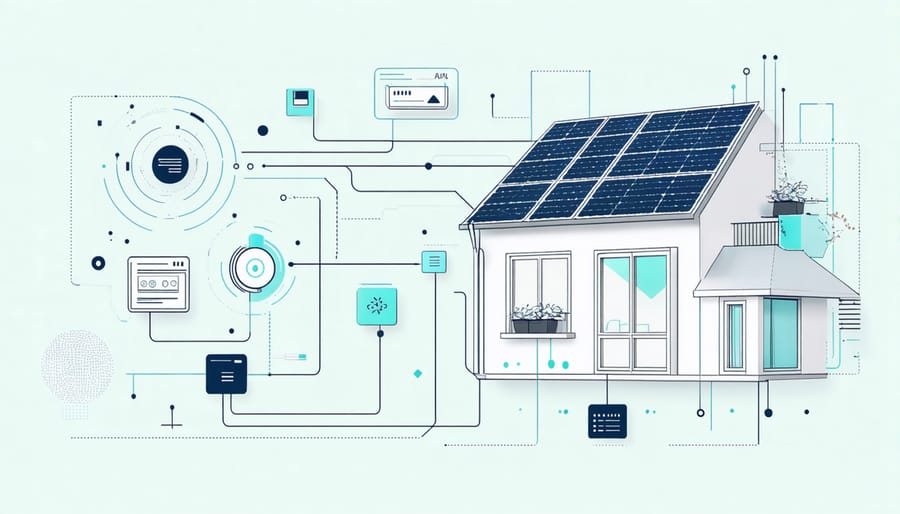
AI-Powered Energy Management
Artificial intelligence is revolutionizing how homeowners harness solar power, making it easier than ever to maximize the benefits of sustainable energy solutions. Smart AI systems now analyze weather patterns, energy consumption habits, and solar panel performance in real-time, automatically adjusting your home’s energy usage for optimal efficiency.
These intelligent systems learn your household’s routines and preferences, predicting when you’ll need more power and when to store excess energy in batteries. For example, if the AI notices you typically run your dishwasher in the evening, it might suggest running it during peak sunlight hours instead, maximizing your solar power usage and reducing grid dependency.
Weather forecasting capabilities allow these systems to prepare for cloudy days by storing extra energy beforehand. When severe weather approaches, the AI can automatically switch to battery power to maintain uninterrupted service. The system also monitors panel performance, alerting you to maintenance needs before problems arise.
Most impressively, AI-powered energy management can reduce your electricity bills by up to 30% through smart load balancing and automated appliance scheduling. The technology continuously adapts to your changing energy needs, ensuring you’re always getting the most from your solar investment while maintaining comfort and convenience.
For homeowners, this means hands-free optimization of their solar system, with the AI handling complex decisions about energy usage, storage, and grid interaction automatically. The result is greater energy independence and significant cost savings, all while contributing to a greener future.
Smart Inverter Technology
Smart inverter technology represents one of the most significant advances in home solar systems, acting as the brain that maximizes your solar panel’s performance. These intelligent devices do much more than simply convert DC power from your panels into usable AC electricity for your home – they actively optimize your entire solar system’s operation.
Modern smart inverters automatically adjust to changing weather conditions, ensuring your panels generate maximum power even during partial shade or cloudy days. They can detect and respond to grid fluctuations, protecting your home’s electrical system while maintaining stable power output. This advanced capability means more consistent energy production and better overall system efficiency.
What makes these inverters truly “smart” is their connectivity features. Through user-friendly mobile apps, you can monitor your system’s performance in real-time, track energy production, and even receive maintenance alerts. Some models can learn from your household’s energy consumption patterns and adjust accordingly, helping you make the most of your solar investment.
Many smart inverters also include built-in safety features that automatically shut down the system during power outages, protecting utility workers and your equipment. When paired with battery storage systems, these inverters intelligently manage power flow between your panels, batteries, and home, ensuring you have electricity when you need it most.
Revolutionary Storage Solutions
Advanced Battery Technology
Recent breakthroughs in battery technology are making solar energy systems more practical and cost-effective than ever before. The latest lithium-ion batteries offer up to 30% more storage capacity compared to models from just five years ago, while prices have dropped by nearly 50% in the same period.
Smart battery systems now automatically optimize energy storage and usage patterns based on your household’s needs. These intelligent systems store excess solar power during peak production hours and distribute it efficiently when needed, reducing reliance on grid power during evenings or cloudy days.
Solid-state batteries, the newest innovation in energy storage, promise even greater benefits. These batteries are safer, longer-lasting, and can operate in extreme temperatures without performance loss. While currently in development, experts predict they’ll be widely available for home solar systems within the next few years.
Flow batteries are another exciting development, especially for larger homes. These batteries can be easily scaled up by simply adding more storage capacity, and they maintain their performance for up to 20 years – nearly twice the lifespan of traditional batteries.
The most exciting part? These advances mean homeowners can now store more solar energy for less money. Many new systems come with user-friendly apps that let you monitor your energy storage and usage in real-time, giving you complete control over your home’s power management.
Virtual Power Plants
Virtual power plants are revolutionizing how we think about residential solar energy by transforming individual home solar systems into interconnected power networks. These smart networks allow homeowners to share excess solar energy with their neighbors, creating a more resilient and efficient community power system.
When multiple solar-equipped homes join forces, they form a virtual power plant that can respond to peak demand periods, balance grid loads, and even provide backup power during outages. This innovative approach to energy management aligns perfectly with broader zero-emission technology adoption goals while offering tangible benefits to participating homeowners.
The system works through smart technology that connects solar panels, battery storage systems, and home energy management devices. When demand is high, the virtual power plant can direct excess power from homes producing more than they need to those requiring additional energy. This sharing economy approach to solar power helps maximize the investment in residential solar systems.
Homeowners participating in virtual power plants often enjoy reduced energy costs, credits for sharing their excess power, and increased energy independence. Some utility companies even offer special incentives for joining these networks, making it an attractive option for solar-equipped homes looking to maximize their clean energy investment while contributing to a more sustainable community power system.
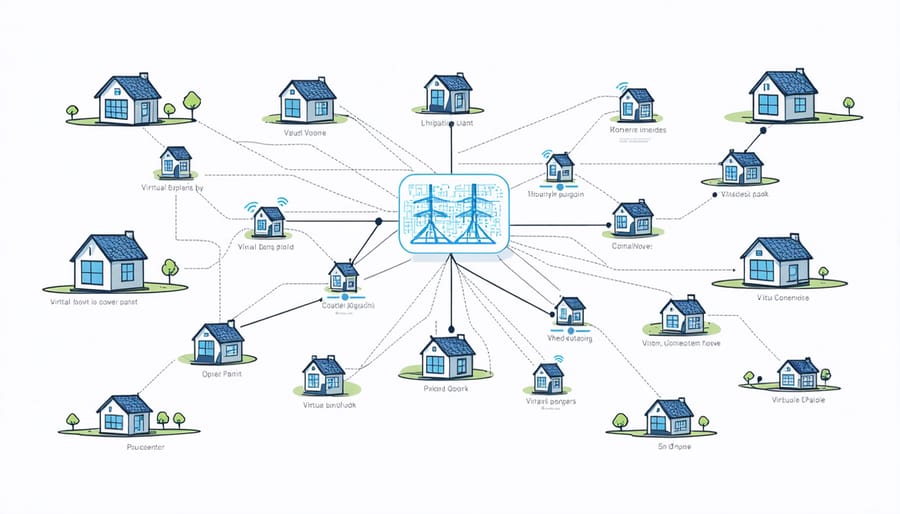
What These Innovations Mean for Your Home
These groundbreaking solar innovations are set to revolutionize how you power your home, making sustainable living more accessible and affordable than ever before. The integration of advanced solar technologies into residential settings means homeowners can now enjoy enhanced energy independence while contributing to a broader renewable energy infrastructure.
With more efficient solar panels hitting the market, you can generate more power using less roof space, making solar viable even for smaller homes. The new generation of panels performs better in low-light conditions, ensuring consistent energy production throughout the day. This translates to lower electricity bills and increased energy independence for your household.
Smart solar systems now offer unprecedented control over your home’s energy consumption. Through user-friendly mobile apps, you can monitor production in real-time, optimize energy usage, and even sell excess power back to the grid. These systems integrate seamlessly with home automation platforms, allowing you to maximize energy efficiency automatically.
The introduction of aesthetically pleasing solar solutions means you no longer have to compromise your home’s appearance. Solar roof tiles and integrated panels blend seamlessly with traditional architecture, while new mounting systems maintain your roof’s integrity. Some designs are so discrete that neighbors might not even notice they’re solar installations.
Storage solutions have also evolved significantly. Advanced batteries now store more energy in a smaller footprint, providing reliable backup power during outages and helping you maximize self-consumption of solar energy. These systems are becoming more affordable, with longer lifespans and better performance than ever before.
Financial benefits have improved too. Enhanced efficiency and falling installation costs mean shorter payback periods, typically ranging from 5-8 years. Combined with available tax incentives and improved property values, solar investments are becoming increasingly attractive for homeowners. Many installations now come with comprehensive warranties and smart monitoring systems that alert you to any maintenance needs, ensuring your investment remains protected for decades to come.
The future of solar energy has never looked brighter, with innovations transforming how we harness and use the sun’s power. From more efficient solar panels that can generate electricity even on cloudy days to integrated home energy systems that maximize power usage, these advancements are making solar energy more accessible and practical for homeowners everywhere.
The impact of recent solar innovations extends beyond individual households to entire communities. Smart grid technologies are enabling neighborhoods to share solar power more effectively, while improved energy storage solutions are making it possible to rely on solar power around the clock. These developments are driving down costs while increasing reliability, making solar an increasingly attractive option for sustainable living.
Looking ahead, the solar industry continues to push boundaries. Researchers are developing transparent solar cells that could transform windows into power generators, while advances in recycling technology are making solar installations more environmentally friendly than ever. As manufacturing processes become more efficient and new materials enter the market, we can expect solar energy to become even more affordable and efficient.
For homeowners considering solar power, there’s never been a better time to make the switch. With continued technological improvements, supportive policies, and decreasing installation costs, solar energy is positioned to play a central role in our sustainable energy future. The innovations we’re seeing today are just the beginning of a solar-powered revolution that will benefit both our planet and our pocketbooks.

